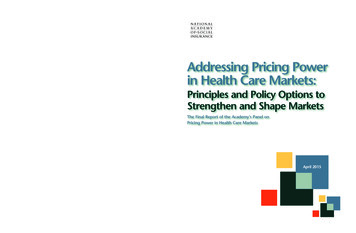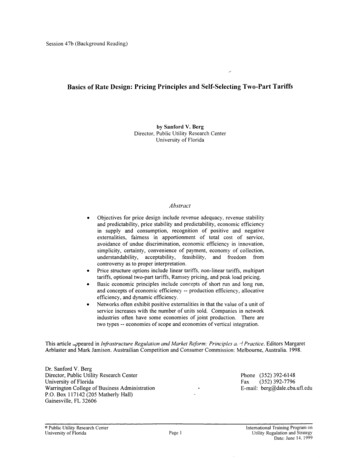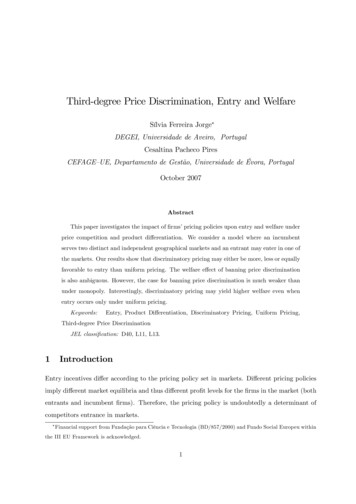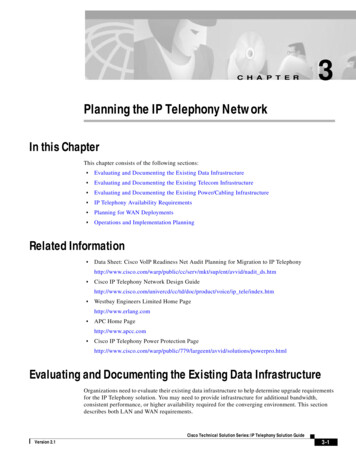
Transcription
1200 New Hampshire Avenue, NW Suite 830 Washington, DC 20036(202) 452-8097 (202) 452-8111 Faxnasi@nasi.org www.nasi.orgPrinted on recycled paper using vegetable-based inks.NATIONAL ACADEMY OF SOCIAL INSURANCE Addressing Pricing Power in Health Care Markets: Principles and Policy Options to Strengthen and Shape Markets1200 New Hampshire Avenue, NW Suite 830 Washington, DC 20036(202) 452-8097 (202) 452-8111 Faxnasi@nasi.org www.nasi.orgAddressing Pricing PowerAddressingPricingPowerinHealth CareMarkets:in HealthandCarePolicyMarkets:PrinciplesOptions toPrinciples hen and Shape MarketsThe Final Report of the Academy’s Panel onThe FinalReportinofHealththe Academy’sPanel onPricingPowerCare MarketsPricing Power in Health Care MarketsApril 2015April 2015
Also available from the AcademyIntegrated Delivery Networks:In Search of Benefits and Market EffectsThe National Academy of Social Insurance (NASI) is a nonprofit, nonpartisan organization made up ofthe nation’s leading experts on social insurance. Its mission is to advance solutions to challenges facingthe nation by increasing public understanding of how social insurance contributes to economic security.Social insurance encompasses broad-based systems for insuring workers and their families against economic insecurity caused by loss of income from work and the cost of health care. NASI’s scope coverssocial insurance programs such as Social Security, Medicare, workers’ compensation, and unemploymentinsurance as well as related public assistance and private employee benefits.The Academy convenes steering committees and study panels that are charged with conductingresearch, issuing findings and, in some cases, reaching recommendations based on their analyses.Members of these groups are selected for their recognized expertise and with due consideration for thebalance of disciplines and perspectives appropriate to the project.d DeliveryIntegrates:rkNetwoitsby Jeff Goldsmith, Lawton R. Burns, Aditi Sen and Trevor Goldsmith, February 2015Any examination of the rolethat hospitals play in healthcare cost growth is complicated by the fact that inmany large markets, hospitals may be part of integrated delivery networks(IDNs), either vertically integrated health services networks that include physicians, post-acute services and/or health plans or fully integrated provider systems inside a health plan. Looking atthe benefits to society, the authors found that there is evidence that IDNs have raised physician costs, hospitalprices and per capita medical care spending; looking atthe benefits to the providers, the evidence also showedthat greater investments in IDN development are associated with lower operating margins and return on capital.As part of this report, the authors conducted a new analysis of 15 of the largest IDNs in the country. While data onhospital performance at the IDN level are scant, theauthors found no relationship between the degree ofhospital market concentration and IDN operating profits,of BenefIn Search EffectsertkePricing PowarMdAddressinganPanel onAcademy’sfor theConductedtsCare Markein Healths,ton R. Burndsmith, Lawby Jeff GolGoldsmithand TrevorAditi Sen2015Februarybetween the size of the IDN’s bed complement or its netcollected revenues and operating profits, no difference inclinical quality or safety scores between the IDN’s flagshiphospital and its major in-market competitor, higher costsof care in the IDN’s flagship hospital versus its in-marketcompetitor, and higher costs of care when more of theflagship hospital’s revenues were at risk.The authors conclude that the public interest would beserved if IDNs provided more detailed routine operatingdisclosures, particularly the amount of hospital operatingprofit as a percentage of the IDN’s total earnings and theIDN’s physician and hospital compensation policies. HowIDNs allocate overhead and ancillary services incomebetween the three main lines of business should also bedisclosed. It should also be possible to determine from anIDN disclosure if capitated risk is transmitted from theIDN’s health plan or risk-accepting organization to itshospitals and physicians. Analysis of societal benefitswould also be materially aided by a comprehensive,national all-payer claims database.State Policies on Provider Market Powerby Suzanne Delbanco and Shaudi Bazzaz, July 2014AcknowledgementsThe National Academy of Social Insurance (NASI) gratefully acknowledges the Robert Wood JohnsonFoundation (RWJF), The California HealthCare Foundation, based in Oakland, California, and the JayneKoskinas Ted Giovanis Foundation for Health and Policy for their generous support of this project.Health care economists broadly agree that the marketpower of certain health care providers is a major driver ofprice increases, and is associated with significant payment variation across and within markets. This report catalogues the laws and regulations that state governmentsare using to enhance the competitiveness of health caremarkets and reduce the ability of providers to use marketpower in such a way that creates negative consequencesfor those who use and pay for care. The authorsresearched regulatory approaches, specifically recentstate efforts pertaining to: antitrust; price and qualitytransparency; competition in health plan contracting;price regulation; the development of Accountable CareOrganizations (ACOs); expanding the authority of stateDepartments of Insurance; and facilitating the entry ofnew providers into the marketplace.Specifically, this paper cataState Policieson Providlogues existing state statuteser Market Powerand regulations that addressthe contracting practices ofhealth plans and providerslikely to reduce competitionand lead to higher prices. Indoing so, this paper provides insight into the current scope of state authority to regulate andmonitor health care prices. In addition, because statesmay pursue policies that would not be captured in areview of laws and regulations, this paper also exploresefforts beyond the legislative realm by states taking anactive role to address these issues.Download the full reports from the Academy website at www.nasi.org.SuzanneDelbancoandShaudi BazzazJuly 2014
Addressing Pricing Powerin Health Care Markets:Principles and Policy Options toStrengthen and Shape MarketsThe Final Report of the Academy’s Panel onPricing Power in Health Care MarketsApril 2015
Study Panel on Addressing Pricing Power in Health Care MarketsRobert Berenson, M.D., Co-ChairInstitute FellowUrban InstituteG. William Hoagland, Co-ChairSenior Vice PresidentThe Bipartisan Policy CenterDavid DranoveWalter J. McNerney Professor of HealthIndustry ManagementNorthwestern University’s Kellogg School ofManagementPaul GinsburgNorman Topping Chair in Medicine and PublicPolicy, Sol Price School of Public Policy, andDirector of Health Policy, Schaeffer Center forHealth Policy and Economics, University ofSouthern CaliforniaRonald LevyExecutive in ResidenceHealth Management & PolicySt. Louis University College of Public HealthSocial JusticeDoug P. McKeeverChiefHealth Policy Research DivisionCalPERSKeith B. PittsVice ChairmanTenet HealthcareBarak D. RichmanBartlett Professor of Law and BusinessAdministrationDuke UniversitySherry A. GliedDean, Robert F. Wagner Graduate Schoolof Public Service, New York UniversityJames C. RobinsonKaiser Permanente Distinguished Professor ofHealth Economics at the School of Public Health,University of California, BerkeleyJeff GoldsmithPresidentHealth Futures, Inc.James Roosevelt, Jr.President and Chief Executive OfficerTufts Health PlanBob Kocher, M.D.PartnerVenrockJohn W. Rowe, M.D.Professor of Health Policy & ManagementColumbia UniversityMailman School of Public HealthWilliam E. KramerExecutive Director for National Health PolicyPacific Business Group on HealthNicholas Wolter, M.D.Chief Executive OfficerBillings ClinicThe views expressed in this report are those of the study panel members and do not necessarilyreflect the organizations with which they are affiliated.
Project StaffJill BraunsteinCommunications DirectorAlwyn CassilPolicy Translation, LLCNatalie ChongIntern (Summer 2014)Alison Evans CuellarConsultantLee GoldbergProject DirectorSabiha ZainulbhaiHealth Policy Associate (through July 2014)DedicationIn memory of Andrew Hyman, without whose vision, passion, and dedication to social insurance anduniversal coverage this project would not have been possible.
Table of ContentsExecutive Summary.1Chapter One: Assessing the Problem of Pricing Power in Health Care Markets .7The Role of Prices in Health Care Spending Growth .7What is Pricing Power? .9Why Health Care Differs from Other Goods and Services .9The Shifting Balance of Power Between Health Plans and Providers .10Insurer Market Power.11Provider Market Power .12Reasons for Provider Market Power .13Consolidated Provider Markets .13Other Aspects of Provider Consolidation .17Market Power and Antitrust Enforcement.17High Prices and Cost Shifting?.19Key Emerging Trends and Market Power.20Fostering Consumer Price-Sensitivity .21Payment Reform .22Hospital Inpatient Care .23Health Plan Competition .23Regulatory and Antitrust Interventions .23Overview of Policy Options.24Chapter Two: Policy Principles .27Chapter Three: Policy Discussion .29Policy Option A: Encouraging Market Entry of Competitors .29National Academy of Social Insurance (NASI)
Policy Option B: Greater Price Transparency.311. Collecting and Reporting All-Payer Claims Data .312. Supporting Price-Conscious Consumers .32Policy Option C: Limiting Anticompetitive Health Plan-ProviderContracting Practices .33Policy Option D: Harmonizing Network-Adequacy with theDevelopment of Limited-Provider Network .34Policy Option E: Active Purchasing by Public Payers.36Policy Option F: Improved Antitrust Enforcement .371. Scrutiny of Hospitals and Insurers with Market Power and theForeclosure of Markets to New Entrants .372. Active Review of Vertical Mergers .383. Conduct Remedies and Post-Merger Monitoring .40Policy Option G: Additional Public Oversight and Review.42Policy Option H: Regulating Premium Increases throughStrengthened Rate Review .43Policy Option I: Limiting Out-of-Network Provider Charges.45Policy Option J: Setting Upper Limits on Permissible, Negotiated ProviderPayment Rates .46Policy Option K: Expanding Use of All-Payer and Private-Payer Rate Setting.47Bibliography .49Endnotes.61
Executive SummaryIn June 2013, the National Academy of Social Insurance (NASI) convened a diverse study panel ofeconomists, antitrust experts, researchers, and hospital and insurance executives to examine the roleand impact of pricing power in the U.S. health care system. While the public sector sets prices administratively, the private sector relies on market-based pricing. In the private sector, pricing power, alsoknown as market power, is defined as the ability of a seller to raise and maintain prices above the levelthat would prevail if the market were competitive.Primarily interested in therole of prices and theircontribution to spendinggrowth, the panel set outDespite spending nearly double the share of gross domestic product onhealth care as other developed nations, care in the United States is unevenat best and ranks poorly by many critical measures compared to other countries. U.S. spending differs from other developed countries for two mainreasons: substantially higher private prices paid for medical care and higheradministrative costs related to health insurance.to think systematicallyabout market power andthe shifting balance ofnegotiating power fromprivate purchasers tohealth care providers overthe last 20 years.Concerns about the lack of price competition are longstanding in healthcare, and the role of market power in the conduct of both health insurersand health care providers is a significant policy issue. Primarily interested inthe role of prices and their contribution to spending growth, the panel setout to think systematically about market power and the shifting balance ofnegotiating power from private purchasers to health care providers over thelast 20 years.Health Care Markets Differ from Other Goods and ServicesThe market for medical care is different from other markets in at least two significant ways: third-party payment for insured consumers and a fundamental imbalance in information and clinical knowledge between patients and clinicians.If insured consumers are able to fulfill their cost-sharing obligations, third-party payment often insulates them from the further costs of their health care decisions and removes the primary incentive forthem to be price conscious and shop for an acceptable level of quality at the lowest price. Health careconsumers also face difficulties in assessing the value of health care services because they typically lackboth clinical knowledge and access to widespread, useable health care price and quality information.While most experts acknowledge that health care is different from other goods and services to somedegree, there is a major division between those who think competition can significantly improve thesituation and those who think health care is fundamentally different in ways that are likely to thwartattempts to create competitive markets.National Academy of Social Insurance (NASI)1
The former group believes that reasonably well-functioning markets can be created through greatertransparency of performance on quality and costs, relaxed barriers to entry of potential competitors,increased consumer financial responsibility for the health care choices they make, and supported byantitrust or other pro-market regulatory approaches. Those who think health care is fundamentallydifferent emphasize unique characteristics that seem fixed and unamenable to pro-market policies:asymmetry of information between buyers and sellers, inherent uncertainty and variation in clinicaldecision-making, desirable insurance protection that society wants but that makes patients relativelyindifferent to costs, and the intermingling of patient care with other activities that benefit society as awhole, including research, education, and care for the uninsured.The Shifting Balance of Power Between Health Plans and ProvidersOver the last two decades, the balance of power between health plans and providers has shifted significantly, albeit to different degrees in different local health care markets. Following a serious recessionand the failure of government health care reform in the early 1990s, managed care emerged as amarket-based response to rapidly rising private health care costs. Employers shifted large numbers ofworkers to managed care products that relied on restrictive provider networks and greater utilizationmanagement.Armed with a credible threat of excluding providers from their networks and the resulting loss ofpatient volume, health plans gained negotiating leverage over hospitals and physicians and obtainedsignificant price discounts. About the same time, however, hospital consolidation picked up speedthrough mergers and acquisitions as hospitals tried to reduce excess capacity, cut expenses, andincrease their clout with insurers.By the late1990s, a significant backlash against tightly managed care developed and, aided by thebooming economy and tight labor markets, negotiating leverage began to swing back to providers,particularly dominant hospitals. Focused more on recruiting and retaining workers, employersabandoned cost controls in favor of broad provider networks, denying health plans an importantbargaining chip with providers — the credible threat of exclusion from plan networks if provider pricedemands were too high.Not surprisingly, spending growth for employer-sponsored insurance accelerated as insurers abandoned narrow-provider networks and tight utilization management controls. Initially, increasedvolume of services played a larger role in private-sector spending growth, but higher prices ultimatelybecame a greater factor. Lacking support from employers to hold the line against provider demands,health plans in many cases effectively called a truce with providers, leading to the existing environment where higher provider payment rates are passed on to employers — and ultimately to employees— through higher premiums.Insurer and Provider Market PowerAs the intermediary between health care providers and insurance purchasers, insurers with marketpower can potentially leverage negotiations in both directions. On one hand, insurers with marketpower have the ability to obtain greater price discounts from providers who need to be in the2Addressing Pricing Power in Health Care Markets
dominant insurer’s provider network; on the other hand, such insurers do not have to actually use thismarket power because they do not face effective competition in selling their insurance products toemployers. Evidence is mixed on the net impact of these two factors on hospital prices.While concerns about insurer market power exist, most recent attention has focused on the marketpower of health care providers — primarily the ability of dominant hospitals and large physician grouppractices to negotiate higher prices. Growing evidence shows that private insurers pay widely varyingprices both across and within local health care markets — sometimes double and triple or more — forthe same medical services.Reasons for Provider Market PowerMarket power and negotiating leverage are derived from a number of complex and mutually reinforcing factors, including provider size, reputation, location, and unique service offerings. Despite thecomplexity of factors contributing to provider market power, much of the policy discussion aboutnegotiating leverage has focused on the size of the provider.Mergers among hospitals to create a single hospital system — horizontal integration — and/orintegration of physician practices and hospitals into larger health systems — vertical integration —recently have garnered attention. Over the last two decades, there has been a steep increase in hospitalmergers and in market concentration. The trend toward consolidation in health care markets continues to accelerate and now includes the absorption of physician practices into hospital systems.Key Emerging Trends and Market PowerIncreased scrutiny of high and widely varying prices for health care services, especiallyhospital care, has helped raise public awareness of the lack of price competiAlthough public policy istion and focus policy attention on the role of provider market power innegotiating prices with insurers. Although public policy is only now comingonly now coming to gripsto grips with the importance of high prices as a major driver of U.S. healthwith the importance ofcare spending growth, payers and purchasers have also been adopting stratehigh prices as a majorgies permitted under current market and regulatory conditions to try todriver of U.S. health carerestrain health care cost growth in general and high provider prices inspending growth, payersparticular. The array of emerging trends related to market power includes:and purchasers have alsobeen adopting strategies Fostering consumer price-sensitivity through greater cost sharing andhealth plan benefit structures that guide patients to more efficientproviders; Launching payment reforms that move from piecemeal fee-for-servicemethods that reward volume regardless of quality to methods placingmore risk on providers for the cost and quality of care; Shifting care from inpatient hospital settings to outpatient care;permitted under currentmarket and regulatoryconditions to try torestrain health care costgrowth in general andhigh provider prices inparticular.National Academy of Social Insurance (NASI)3
Encouraging health plan competition in the individual and small-group markets throughstate health insurance exchanges; and Intervening in markets through state and federal regulatory and antitrust enforcementactions.Policy PrinciplesWith a diverse group of national experts participating, the Academy study panel developed a set ofpolicy principles to provide a starting point for crafting policy that would address market power inhealth care markets (see Chapter 2 for the complete principles). Substantively, these principles reflect apreference for market solutions and for targeted regulation in markets that lack competition — insome cases because of provider consolidation — or where new competitors are unlikely to enter themarket. These principles recognize the need for policy to address broader societal goals — for example, around issues of access and quality — but the panel believes that meeting these societal goalsshould explicitly recognize the potential impact on prices and competition. Finally, the principlesreflect the important role of competition in generating new ideas about institutions and mechanismsfor innovative ways to deliver care that can increase both quality and efficiency.Policy Principles 4Market competition is often the best way to motivate providers to increase efficiency,improve quality, and ensure that health care prices reflect the value of services provided to consumers. Where unfettered market competition is ineffective, public policy canenhance market competition or, if that is not likely to be successful, regulate prices directly. When they work well, competitive markets weed out providers that fail toefficiently deliver services that are valued by consumers. While some inefficientproviders may lose business or even exit the market, consumers benefit from theoverall improvements in efficiency and quality that emerge from competition. Competitive markets generate prices that reflect the cost and value of services andpromote innovations in health care delivery, including the development of newinstitutional mechanisms for the delivery and organization of care. In the long run,these innovations may provide substantial benefits to patients. Health care markets are local, and policy interventions that address market failuresshould be tailored to local markets. In many markets, there has been significanthospital consolidation to the degree that unregulated markets are unlikely togenerate competition that will lead to efficient prices or innovation.Addressing Pricing Power in Health Care Markets
Policy Principles continued There is a broad scope of regulatory interventions to foster competition, includingtargeting more aggressive antitrust enforcement, prohibiting providers fromdemanding favorable treatment as a condition of contracting, and directly limitingprices through administrative means. However, all regulation risks so-called capture — or undue influence —byregulated entities. Just as markets may not work in every situation, regulation hascosts and benefits that vary by context. Regulatory capture has in some situationsled price regulation to be only marginally effective, if at all. Along with care for patients, hospitals and physicians often provide additionalservices with significant social value, including research, medical training, anduncompensated care. In a competitive market, prices are unlikely to support thesepublic goods. Increased competition leads to the additional need for specificpolicies to support such activities. Greater transparency that provides consumers with accurate and timely informationabout price, quality, costs, and provider networks likely can help them make betterchoices and, in some cases, make markets more competitive. Greater transparency alsomay improve the functioning of markets by exposing market conditions and marketbehavior to public scrutiny. At the same time, policymakers must guard againstproviders or plans using price information for collusive purposes. The benefits of emerging payment reforms and delivery systems, such as ACOs andother provider configurations, may improve quality but also can contribute to excessivemarket consolidation. Policymakers should carefully evaluate known costs and benefitsbefore making exceptions to competition laws to encourage new but unprovedpayment and delivery systems. Forcing highly integrated systems to divest if they do notdeliver value is a formidable challenge. Significant variations in provider prices should reflect real differences in costs related totheir missions or to consumer preferences in well-functioning markets, not vagaries ofnegotiating leverage that might produce inequitable prices of services, placingproviders in very different financial circumstances unrelated to their own performance.Policy OptionsRecognizing that no single policy option would be applicable to all local markets — that there is no“silver bullet” to address the lack of price competition — the study panel produced a range of policyoptions. The policy options assume that laws and regulations can help foster competition by imposing rules of conduct and by addressing barriers to competition.National Academy of Social Insurance (NASI)5
The policy options should not be seen as either a packaged set or as competing alternatives. Wherefeasible, policy solutions should be crafted to reflect local health care market conditions. The policyoptions follow a continuum based on how vigorously they intervene in the market from least to most:Policy Options Policy Option A:Encouraging Market Entry of Competitors Policy Option B:Greater Price Transparency1. Collecting and Reporting All-Payer Claims Data2. Supporting Price-Conscious Consumers Policy Option C:Limiting Anticompetitive Health Plan-ProviderContracting Provisions Policy Option D:Harmonizing Network-Adequacy Requirements withthe Development of Limited-Provider Networks Policy Option E:Active Purchasing by Public Payers Policy Option F:Improved Antitrust Enforcement1. Scrutiny of Hospitals and Insurers with Market Powerand the Foreclosure of Markets to New Entrants2. Active Review of Vertical Mergers3. Conduct Remedies and Post-Merger Monitoring6 Policy Option G:Additional Public Oversight and Review Policy Option H:Regulating Premium Increases through StrengthenedRate Review Policy Option I:Limiting Out-of-Network Provider Charges Policy Option J:Setting Upper Limits on Permissible, Negotiated ProviderPayment Rates Policy Option K:Expanding the Use of All-Payer and Private-PayerRate SettingAddressing Pricing Power in Health Care Markets
CHAPTER ONEAssessing the Problem of Pricing Power inHealth Care MarketsThe Role of Prices in Health Care Spending GrowthAlthough U.S. health care spending growth has moderated in recent years, rising health care costs remain a critical domestic policy issue, especially as more Americans gain health insurance. Maintainingthe significant coverage gains under the Affordable Care Act (ACA), in large part, depends on keeping health care affordable. In 2011, the United States spent 17.7 percent of gross domestic product(GDP), or 2.7 trillion, on health care, compared to an average of 9.4 percent of GDP for otherdeveloped nations in the Organization for Economic Cooperation and Development (OECD).1Higher U.S. spending does not produce better quality care — care in the UnitedStates is uneven at best and ranks poorly by many measures. The UnitedStates also has fewer hospital admissions and fewer physician visits p
and impact of pricing power in the U.S. health care system. While the public sector sets prices admin-istratively, the private sector relies on market-based pricing. In the private sector, pricing power, also known as market power, is defined as the ability of a seller to raise and maintain prices above the level










